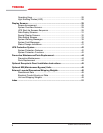
3
1600EP Series Instruction Manual
IMPORTANT SAFETY INSTRUCTIONS
This manual contains important instructions that should be followed during the installation and maintenance
of the UPS and its batteries.
Hardwire-type UPS units are not equipped with an over-current protection device nor an output disconnect
for the AC output. A circuit breaker should be provided by the user between the UPS output and the load
input. This device should be rated as follows:
240VAC
RATING
3.6RoHS kVA 3.6 kVA 6 kVA 8 kVA 10 kVA 14 kVA 18 kVA 22 kVA
20 A 20 A 30 A 40 A 60 A 80 A 125 A 150 A
The nominal battery voltages for these models are as follows:
BATTERY
VOLTAGE
3.6RoHS kVA 3.6 kVA 6 kVA 8 kVA 10 kVA 14 kVA 18 kVA 22 kVA
144 Vdc 216 Vdc 216 Vdc 288 Vdc 288 Vdc 288 Vdc 288 Vdc 288 Vdc
Servicing of the batteries should only be performed by a qualied factory authorized representative who
is knowledgeable of batteries and the required precautions. Keep unauthorized personnel away from
batteries. To arrange for battery replacement, contact your nearest factory authorized service center.
Turn off, lockout, and tagout all equipment before connecting the power wiring to the equipment ow
when performing maintenance.
Hardwire type UPS units are not equipped with an over-current protection device, nor do they have
an output disconnect for the AC output. Therefore, a user-installed circuit breaker should be provided
between the UPS output and the load input.
The maximum ambient operating temperature is 104 °F (40 °C).
Battery servicing should be performed by qualied Toshiba representative only.
Unauthorized personnel should not service batteries.
Contact your Toshiba authorized service center for battery replacement.
QUALIFIED PERSONNEL ONLY
is one that has the skills and knowledge relating to the construction, installation,
operation, and maintenance of the electrical equipment and has received safety training on the hazards
involved (Refer to the latest edition of NFPA 70E for additional safety requirements).
Have read the entire operation manual.
Be trained and authorized to safely energize, de-energize, ground, lockout and tag circuits and
equipment, and clear faults in accordance with established safety practices.
Be trained in the proper care and use of protective equipment such as safety shoes, rubber gloves,
hard hats, safety glasses, face shields, ash clothing, etc., in accordance with established safety
practices.
Be trained in rendering rst aid.
Be knowledgeable of batteries and the required handling and maintenance precautions.
For further information on workplace safety visit www.osha.gov.
1.
2.
3.
4.
5.
6.
1.
2.
3.
4.
5.


















